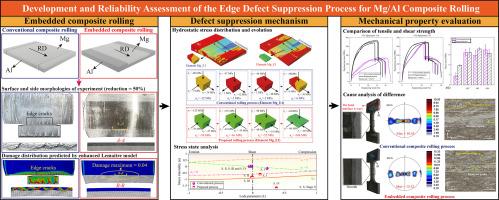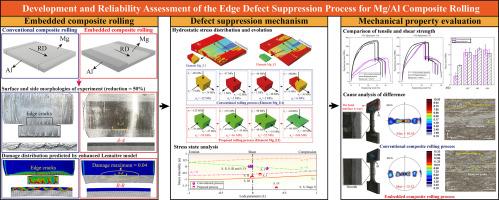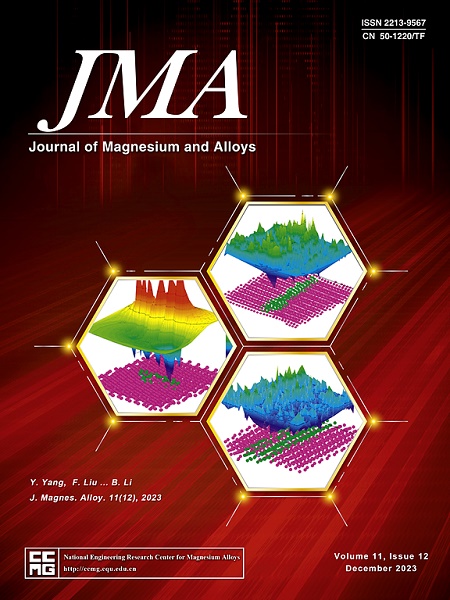Research on edge defects suppression of Mg/Al composite plate rolling: Development of embedded rolling technology
IF 13.8
1区 材料科学
Q1 METALLURGY & METALLURGICAL ENGINEERING
引用次数: 0
Abstract
Edge defects significantly impact the forming quality of Mg/Al composite plates during the rolling process. This study aims to develop an effective rolling technique to suppress these defects. First, an enhanced Lemaitre damage model with a generalized stress state damage prediction mechanism was used to evaluate the key mechanical factors contributing to defect formation. Based on this evaluation, an embedded composite rolling technique was proposed. Subsequently, comparative validation was conducted at 350 °C with a 50% reduction ratio. Results showed that the plates rolled using the embedded composite rolling technique had smooth surfaces and edges, with no macroscopic cracks observed. Numerical simulation indicated that, compared to conventional processes, the proposed technique reduced the maximum edge stress triaxiality of the plates from −0.02 to −1.56, significantly enhancing the triaxial compressive stress effect at the edges, which suppressed void nucleation and growth, leading to a 96% reduction in damage values. Mechanical property evaluations demonstrated that, compared to the conventional rolling process, the proposed technique improved edge bonding strength and tensile strength by approximately 67.7% and 118%, respectively. Further microstructural characterization revealed that the proposed technique, influenced by the restriction of deformation along the transverse direction (TD), weakened the plastic flow in the TD and enhanced plastic flow along the rolling direction (RD), resulting in higher grain boundary density and stronger basal texture. This, in turn, improved the toughness and transverse homogeneity of the plates. In summary, the embedded composite rolling technique provides crucial technical guidance for the preparation of Mg-based composite plates.


Mg/Al复合板轧制边缘缺陷抑制研究:嵌入式轧制技术的发展
在轧制过程中,边缘缺陷对Mg/Al复合板的成形质量影响很大。本研究旨在开发一种有效的轧制技术来抑制这些缺陷。首先,采用具有广义应力状态损伤预测机制的改进Lemaitre损伤模型,对影响缺陷形成的关键力学因素进行评估;在此基础上,提出了一种嵌入式复合轧制技术。随后,在350°C下进行对比验证,还原率为50%。结果表明:采用预埋式复合轧制技术轧制的板材表面和边缘光滑,无宏观裂纹;数值模拟结果表明,与传统工艺相比,该工艺将板的最大边缘应力三轴度从- 0.02降低到- 1.56,显著增强了边缘的三轴压应力效应,抑制了空洞的形核和生长,导致损伤值降低了96%。力学性能评估表明,与传统轧制工艺相比,该工艺的边缘结合强度和拉伸强度分别提高了67.7%和118%。进一步的显微组织表征表明,受沿横向变形限制的影响,该技术减弱了沿横向变形的塑性流动,增强了沿轧制方向的塑性流动,从而导致更高的晶界密度和更强的基底织构。这反过来又提高了板的韧性和横向均匀性。综上所述,复合材料预埋轧制技术为制备镁基复合材料板提供了重要的技术指导。
本文章由计算机程序翻译,如有差异,请以英文原文为准。
求助全文
约1分钟内获得全文
求助全文
来源期刊

Journal of Magnesium and Alloys
Engineering-Mechanics of Materials
CiteScore
20.20
自引率
14.80%
发文量
52
审稿时长
59 days
期刊介绍:
The Journal of Magnesium and Alloys serves as a global platform for both theoretical and experimental studies in magnesium science and engineering. It welcomes submissions investigating various scientific and engineering factors impacting the metallurgy, processing, microstructure, properties, and applications of magnesium and alloys. The journal covers all aspects of magnesium and alloy research, including raw materials, alloy casting, extrusion and deformation, corrosion and surface treatment, joining and machining, simulation and modeling, microstructure evolution and mechanical properties, new alloy development, magnesium-based composites, bio-materials and energy materials, applications, and recycling.
 求助内容:
求助内容: 应助结果提醒方式:
应助结果提醒方式:


